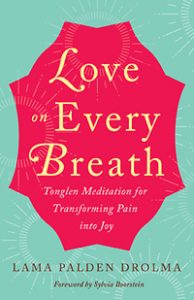The Eight Steps of Love on Every Breath
 An excerpt from LOVE ON EVERY BREATH by Lama Palden Drolma
An excerpt from LOVE ON EVERY BREATH by Lama Palden Drolma
At this time, when our human family is facing many challenges, it is more important than ever that we find peace and sustenance in our hearts. In the new book Love on Every Breath: Tonglen Meditation for Transforming Pain into Joy, author Lama Palden Drolma introduces a profound, ancient meditation that has been practiced in isolated mountain retreats in the Himalayas for centuries, which is now available to the modern world.
In the standard Tonglen, the meditator simply breathes in the suffering of others and then breathes out love and compassion to them, but this approach does not always work well for Westerners, who often find it difficult to get past the ego’s roadblocks. That is why Lama Palden prefers to teach the more user-friendly “Love on Every Breath” variation to Westerners, which comes from the Shangpa lineage of two enlightened women.
We hope you’ll enjoy this excerpt from the book.
# # #
Love on Every Breath is an ancient Tibetan Buddhist Vajrayana meditation from the Shangpa lineage that combines breath, awareness, imagination, and an energetic transformation process. The meditation brings all these components together in a powerful way in order to open our hearts, to reveal and cultivate our kindness, love, compassion, and wisdom. In Tibetan, this is called the Extraordinary Tonglen, since it uses special techniques of Vajrayana to transform suffering. The Tibetan word tonglen is composed of two words — tong means “giving or sending,” and len means “receiving or taking.” First, we open ourselves to receive and feel the suffering of ourselves and others, breathing it into our heart center. This is the “taking.” The suffering is then instantaneously and effortlessly liberated in the heart and transformed by a special method into unconditional love. At this point, on the out-breath, love and healing energy are sent back out to whomever you are doing the meditation for at the moment, whether yourself or another. This is the “sending.”
The primary purpose of the Love on Every Breath meditation is to cultivate our love and compassion, to transform and liberate our heart. When we come from a place of love, everything shifts for us. This book gives you the tools to transform and empower yourself and come to a place of creative engaged freedom.
The Love on Every Breath meditation is not an exotic Himalayan practice, but it is something that emerges out of us spontaneously and naturally. It is inherent in us to want to remove suffering — others’ or our own. The problem for many children (and adults) is that we absorb the suffering of others, and then it stagnates inside of us. Love on Every Breath gives a way for the suffering to be liberated in the body and the psyche and emerge as compassion. There is a felt sense as this happens.
The Eight Steps of Love on Every Breath
The Love on Every Breath meditation has eight steps. The complete meditation is done as a sitting practice and takes about forty-five minutes to an hour from start to finish, but the practice is highly adaptable and can be easily abbreviated.
Here is a brief description of each step. In step 1, Resting in Open Awareness, we let go of everything. We let go of the past and the future; we let go of any and all ideas about ourselves or others; we completely let go into our bodies and into relaxing. We become aware of our mind so that we don’t allow it to wander into thinking. Rather, we stay present with what is. Usually, the easiest way to do this is to join our attention and breath. This anchors us in our body, and in our felt sensations, instead of in our thoughts. This is a doorway into calm abiding. We simply rest in awareness and openness; openness is synonymous with emptiness.
In step 2, Seeking Refuge in Awakened Sanctuary, we go for refuge, for sanctuary, to the awakened ones. This helps create a context and the space for our meditation. We also ask the buddhas and other awakened beings to support us during our meditation.
In step 3, Cultivating Awakened Mind, we engender the altruistic intention to fully awaken to be able to help liberate all beings from suffering.
In the fourth step, Stepping into Love, we invite an awakened being, traditionally Chenrezig, the Bodhisattva of Compassion, to be present above the crown of our head.
Following our heartfelt prayers, Chenrezig dissolves into ourselves, and we meditate that we become inseparable from Chenrezig. The awakened mind is then established in the heart center as a crystal vajra of light, which is a symbol of the indestructible, pure luminous empty reality of who we truly are, our buddha nature. The vajra is what transforms the suffering — not our individual personality or ego. This saves our ego from saying, “I don’t want to take in more suffering! I have enough of my own!”
The Vajra that Appears in our Heart Center
In the fifth step, Taking and Sending for Yourself, we imagine our ordinary self in front of us and contemplate our pain and wounds, meeting ourselves with loving awareness. We breathe in our suffering as a dark smoke-like substance, breathing it right into our heart center. As soon as it touches the vajra of light, we visualize a lightning bolt arising from the vajra, transforming all suffering into white light, symbolic of unconditional awakened love and healing energy. When we are breathing out, this white light goes into the heart center of our ordinary self, where it heals, illuminates, and awakens.
In the sixth step, Taking and Sending for Others, we meditate on a loved one, and gradually we include others. As in the previous step, we contemplate their suffering, big and small, see it as dark smoke, and breathe it into the vajra in our heart. When the suffering touches the vajra, it is instantly transformed. Then, on the out-breath, we imagine the white light going into the person or people, filling them with light and healing, and eventually bringing about their awakening.
Chenrezig, together with the vajra of awakening, greatly enlarges our capacity to welcome the suffering and transform it. Slowly we expand our meditation out to various people and groups of people, until finally all beings are included. We rest in the love and joy of all of us awakened together.
Step 7, Dissolving, involves dissolving our visualization, completely letting go, and resting in open awareness. Then in step 8, Dedicating, we dedicate any and all benefit of our meditation to the awakening of all beings.
# # #
 Lama Palden Drolma is the author of Love on Every Breath. A licensed psychotherapist, spiritual teacher, and coach, she has studied Buddhism in the Himalayas with some of the most preeminent Tibetan masters of the twentieth century. Following a traditional three-year retreat under his guidance, Kalu Rinpoche authorized her to become one of the first Western lamas. She subsequently founded the Sukhasiddhi Foundation, a Tibetan Buddhist teaching center in Fairfax, California. Visit her online at http://www.lamapalden.org.
Lama Palden Drolma is the author of Love on Every Breath. A licensed psychotherapist, spiritual teacher, and coach, she has studied Buddhism in the Himalayas with some of the most preeminent Tibetan masters of the twentieth century. Following a traditional three-year retreat under his guidance, Kalu Rinpoche authorized her to become one of the first Western lamas. She subsequently founded the Sukhasiddhi Foundation, a Tibetan Buddhist teaching center in Fairfax, California. Visit her online at http://www.lamapalden.org.
Excerpted from the book Love on Every Breath. Copyright © 2019 by Lama Palden Drolma. Printed with permission from New World Library — www.newworldlibrary.com.









